TikTok made me buy it: microtrends and mass throwaway consumerism
The short life of trends, fueled by social media, has changed the way we consume

The micro mini skirt, the dress from 13 Going on 30 or the black cut-out dress worn by Maddy in Euphoria, choker necklaces with flowers, to name just a few. These are some of the micro trends that have grabbed our attention over the last few years. Before the pandemic and the rise of TikTok, trends emerged from the catwalks, incorporating small cultural details along the way. But how do things change when fashion is rooted in a generation that is constantly connected to the internet?
Trends are one of the cornerstones of fashion, but social media has drastically accelerated their momentum. In the past, the cycle of trends used to last between 5 and 10 years, and they were introduced by people like singers, actresses, models, and celebrities. However, nowadays, they are also set by influencers or anyone with a presence on social media who is able to reach a certain audience. These short-lived trends are referred to as “micro trends.”

Micro trends are fads that experience a surge in popularity before fading just as quickly. They often spring up naturally on platforms like TikTok, where they are started by popular creators, then quickly rise to prominence and creep onto every user’s “For You” page. In about a month, or even less, the micro trend falls out of fashion and no one talks about it again.

The problem surfaces when fast fashion chains like Shein catch on and make them easily accessible, leading to overconsumption. To ensure that all the new products arrive on time, the conditions in which they are manufactured are often unethical, using poor quality materials and even traces of toxic chemicals have been found in some garments.
In her book The Psychology of Fashion, Carolyn Mair explores the desire to purchase trend after trend and the way this is not about attention span but habit. When viewers witness how other people rejoice at being seen in the clothes they are wearing, they develop a desire to purchase the same garment. Once they get used to this feeling, it motivates them to keep buying in the hope of reviving that pleasure and excitement.

‘Disinfluence’
In contrast, content creators are joining the “de-influencing” or “anti-hauls” movement. These two terms relate to teaching and conveying to viewers the things they don’t need or what is not worth buying. This is a poke at over-consumption and impulse buying that is intended to spark a general reflection on how popular products are not always the best or a necessary purchase.
By repeatedly observing micro trends, the association with them becomes stronger, and this influences the decision of consumption. However, the frequency with which we view something like UGG slippers does not mean that it is the hot trend of the moment or the star garment. De-influencing is about emphasizing that we can all consider these factors, including the reason we really want to make a purchase, before adding it to our shopping basket.
Certainly, thanks to the number of different aesthetics that TikTok has popularized, it is easier for you to adapt your wardrobe to your personal style, as it offers you ever-evolving style guides. However, it is wise to be clear about the reason for your purchase. Making decisions with what favors you as a starting point rather than the micro-trend of the moment will always be the recipe for success.

Sign up for our weekly newsletter to get more English-language news coverage from EL PAÍS USA Edition
Tu suscripción se está usando en otro dispositivo
¿Quieres añadir otro usuario a tu suscripción?
Si continúas leyendo en este dispositivo, no se podrá leer en el otro.
FlechaTu suscripción se está usando en otro dispositivo y solo puedes acceder a EL PAÍS desde un dispositivo a la vez.
Si quieres compartir tu cuenta, cambia tu suscripción a la modalidad Premium, así podrás añadir otro usuario. Cada uno accederá con su propia cuenta de email, lo que os permitirá personalizar vuestra experiencia en EL PAÍS.
¿Tienes una suscripción de empresa? Accede aquí para contratar más cuentas.
En el caso de no saber quién está usando tu cuenta, te recomendamos cambiar tu contraseña aquí.
Si decides continuar compartiendo tu cuenta, este mensaje se mostrará en tu dispositivo y en el de la otra persona que está usando tu cuenta de forma indefinida, afectando a tu experiencia de lectura. Puedes consultar aquí los términos y condiciones de la suscripción digital.
More information
Archived In
Últimas noticias
Most viewed
- Sinaloa Cartel war is taking its toll on Los Chapitos
- Oona Chaplin: ‘I told James Cameron that I was living in a treehouse and starting a permaculture project with a friend’
- Reinhard Genzel, Nobel laureate in physics: ‘One-minute videos will never give you the truth’
- Why the price of coffee has skyrocketed: from Brazilian plantations to specialty coffee houses
- Silver prices are going crazy: This is what’s fueling the rally










































